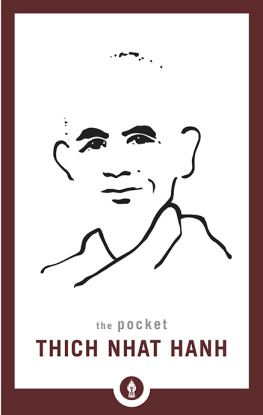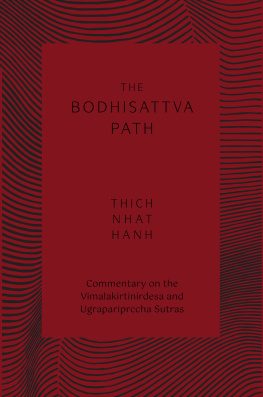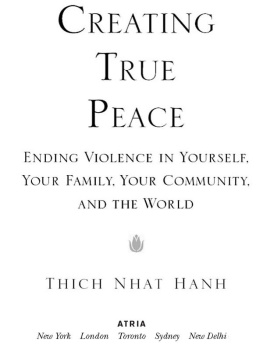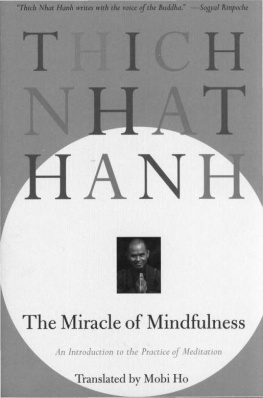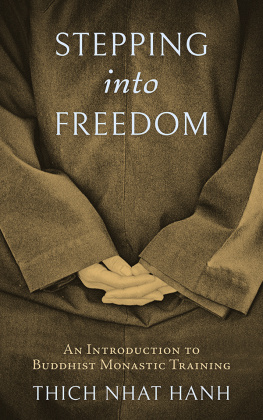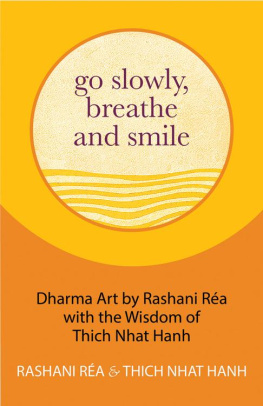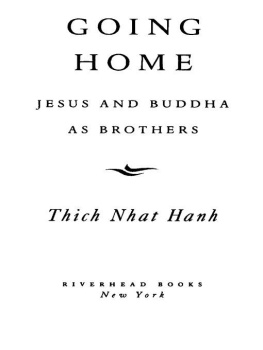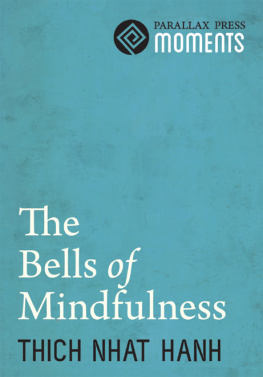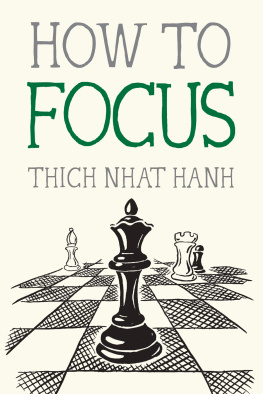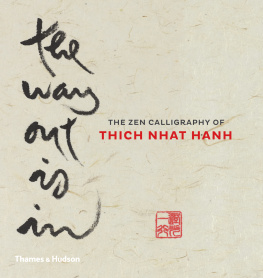ABOUT THE BOOK
This is a collection of powerful and inspiring teachings in an appealing, convenient pocket-size book from one of todays most important and beloved spiritual teachers, the Zen Buddhist monk Thich Nhat Hanh. Next to His Holiness the Dalai Lama, Thich Nhat Hanh is the best-known Buddhist teacher in the world, and his teachings have touched millions.
Thich Nhat Hanh is known for his warm, generous, and joyful teaching style that makes his wisdom remarkably accessible and resonant to readers from all backgrounds. These selected writings are drawn from Thich Nhat Hanhs many published works and provide a wonderful overview of his teachings. This reader covers the main themes that Thich Nhat Hanh has addressed as a Buddhist teacher: mindfulness in our daily lives, Buddhism and enlightenment, working with emotions and relationships, and transforming society (engaged Buddhism).
A Vietnamese Zen Buddhist monk, THICH NHAT HANH is an internationally known author, poet, scholar, and peace activist, and was nominated for the Nobel Peace Prize by Martin Luther King Jr. He is the author of numerous books, including the best-selling Living Buddha, Living Christ; Anger: Wisdom for Cooling the Flames; Peace Is Every Step; and The Miracle of Mindfulness. He is the leader of monastic communities in New York, California, France, Germany, Hong Kong, and Vietnam, and his teachings inspire several hundred local groups of lay practitioners across the United States, Latin America, Europe, Africa, Asia, and Oceania.
Sign up to learn more about our books and receive special offers from Shambhala Publications.

Or visit us online to sign up at shambhala.com/eshambhala.
THE POCKET THICH NHAT HANH
Compiled and Edited by
MELVIN MCLEOD

SHAMBHALA
Boulder
2012
Shambhala Publications, Inc.
4720 Walnut Street
Boulder, Colorado 80301
www.shambhala.com
2012 by the Unified Buddhist Church
Cover art by Robert Spellman
Cover design by Jim Zaccaria
All rights reserved. No part of this book may be reproduced in any form or by any means, electronic or mechanical, including photocopying, recording, or by any information storage and retrieval system, without permission in writing from the publisher.
LIBRARY OF CONGRESS CATALOGING-IN-PUBLICATION DATA
Nht Hnh, Thch
[Works. Selections. 2012]
The pocket Thich Nhat Hanh / compiled and edited by Melvin McLeod.First Edition.
pages cm
eISBN 978-0-8348-2814-8
ISBN 978-1-59030-936-0 (pbk.)
1. Religious lifeBuddhism.
I. Mcleod, Melvin, editor of compilation. II. Title.
BQ9800.T5392N452 2012
294.3927dc23
2012005545
CONTENTS
W E GAUGE THE GREATNESS of spiritual teachers by the depth, breadth, and impact of their teachings, and by the example their lives set for us. By all these measures, Thich Nhat Hanh is one of the leading spiritual masters of our age. In fact, when the time has come to judge such things, I think he will be considered one of historys great Buddhist masters.
Like a mighty river, the teachings of Thich Nhat Hanh are deep and wide. What can be said of their depth, indeed the deepness of any spiritual teaching? Profundity must be experienced; it cannot be described. These teachings cannot be fathomed by words. All I can say is that you should not be misled by their apparent simplicity, by their directness, practicality, and relevance that could be taken for a lack of philosophical sophistication. It takes a long and hard journey to arrive at such clarity, in which the problems of life are finally resolved in plain, essential language that makes deep truths available to all who want to see them. Far more than the opposite, such purity and simplicity of language is the hallmark of true profundity.
I have tried in this book to select excerpts from Thich Nhat Hanhs large body of published work that honor the depth of his teachings, choosing passages that I feel epitomize most effectively his key insights and instructions. Yet as your experience of these teachings will be personal and subjective, so is mine. As a student of Buddhism for many years, all I could doand can the editor of such a book ever do anything else?is to select those passages that touch my own heart, life, and practice most deeply. All I can hope is that they touch you too.
Just as challenging is to reflect the unique breadth of this great masters teachings. No other Buddhist teacher todayperhaps no spiritual teacher in any traditionaddresses such a wide range of important questions, from the personal to the global.
Thich Nhat Hanh has written more than seventy books and given innumerable hours of personal teachings over a career of more than sixty years. His writings range from in-depth dissertations on Buddhist philosophy and popular works on Buddhist practice to political works, psychology, poetry, history, childrens books, and fiction.
In surveying this vast body of writings, my aspiration is that this book will introduce you to the themes in Thich Nhat Hanhs work that are most important for the Buddhist practitioner and general reader. Organizing these diverse teachings is necessarily a subjective exercise. In my own study and practice of his teachings, I have found that they fall into four broad categories: Mindfulness, Enlightenment, Emotions and Relationships, and Peace.
The opening section of this anthology, Mindfulness, includes many of the teachings for which Thich Nhat Hanh is most famous. Like all great Buddhist masters, he is above all a teacher of meditation. He offers us profound and practical methods we can use both in our formal meditation practice and in our lives. Whether they are in plain or poetic language, these teachings strike right at the heart of life. If we can truly follow his instructions, even for a moment, they will transform us on the spot, filling our lives with joy, enjoyment, and virtue.
From that place, our true home, as Thich Nhat Hanh calls it, he takes us on an even more transformative journey, into the most profound truths of Buddhism. So in the second section of this book, Enlightenment, we learn about a path that takes us beyond ignorance, beyond struggle, beyond birth and death itself. This is the journey to complete liberation, and it can start right now. In this section we see Thich Nhat Hanh not just as a teacher of popular spirituality but as a deeply realized Buddhist teacher, speaking to us directly from his experience of true liberation. Like all great Buddhist masters, he speaks to us with the voice of the Buddha.
In section three, Emotions and Relationships, we return to our daily lives in this modern worldthe ups and downs, the joys and sorrows, the suffering we cause others and the pain they cause us. I dont know how this elderly Vietnamese monk understands us so well, but he offers some of the most helpful and practical advice anywhere for working with our psychological wounds and relationship problems. Beginning with the traditional Buddhist understanding of the workings of mind, he shows us a powerful path to healing our wounded modern psyches. Since it is the wounds within us that beget the wounds we inflict on others, this is also the path to healthy and loving relationships. It is, finally, the path to a healthy and loving world.
In the Mahayana Buddhist tradition from which Thich Nhat Hanh comes, personal liberation is never enough. Until all are healed, none is healed. This is the way a bodhisattva like Thich Nhat Hanh sees the world. He is renowned as the founder of the Engaged Buddhist movement, and in the final section of this book, Peace, we sample his teachings on politics, society, and the environment. All these teachings, ultimately, are about creating peacebetween people, between religions, between nations, between humanity and the earth. And since peace always begins within us, this book concludes with Thich Nhat Hanhs famed Five Mindfulness Trainings, a discipline of peace, ethics, and caring to transform our lives, our relationships, and our society.
Next page
